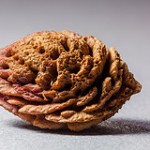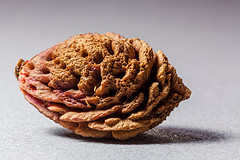 Archeologists have a good understanding of domestication – conscious breeding for traits preferred by people– of annual plants such as grains (rice, wheat, etc.), but the role of trees in early farming and how trees were domesticated is not well documented. Unlike most trees, the peach matures very quickly, producing fruit within two to three years, so selection for desirable traits could become apparent relatively quickly. The problem that Crawford and his colleagues faced was how to recognize the selection process in the archeological record.
Archeologists have a good understanding of domestication – conscious breeding for traits preferred by people– of annual plants such as grains (rice, wheat, etc.), but the role of trees in early farming and how trees were domesticated is not well documented. Unlike most trees, the peach matures very quickly, producing fruit within two to three years, so selection for desirable traits could become apparent relatively quickly. The problem that Crawford and his colleagues faced was how to recognize the selection process in the archeological record.
Peach stones are well represented at archeological sites in the Yangtze valley, so they compared the size and structure of the stones from six sites that spanned a period of roughly 5,000 years. By comparing the size of the stones from each site, they were able to discern peaches growing significantly larger over time in the Yangtze valley, demonstrating that domestication was taking place. The first peach stones in China most similar to modern cultivated forms are from the Liangzhu culture, which flourished 4,300 to 5300 years ago.
“We’re suggesting that very early on, people understood grafting and vegetative reproduction, because it sped up selection,” Crawford said. “They had to have been doing such work, because seeds have a lot of genetic variability, and you don’t know if a seed will produce the same fruit as the tree that produced it. It’s a gamble. If they simply started grafting, it would guarantee the orchard would have the peaches they wanted.”
via It’s the pits: Ancient peach stones offer clues to fruit’s origins.
